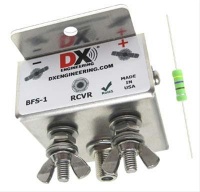
Beverage Transformers for HF Receiving Antennas
Matt Roberts - matt-at-kk5jy-dot-net
Published: 2023-04-10
Updated: 2023-07-09
Some of the most common questions I receive relate to how to build
a Beverage transformer for use in one of my receiving antenna
designs. Such a home-made transformer was described in my
loop-on-ground article, but I use them in
most of my receiving antenna projects.
This article is a brief
FAQ
about the transfomers I use, how to build them, and where to buy
them.
Q: How do I build my own transformer?
The isolation transformer used in my receiving antenna articles
is not my original design. I used the transformer
described by W8JI in
his own article about
beverage antennas (w8ji.com). Scroll down to the
Transformers section of his article for all the
information you need to build your own transformer, including
the model number of the core he used.
Q: Where do I buy transformer cores?
I get them from Mouser.
As of the writing of this article in springtime 2023, they are
available from Mouser
for $0.36 each in quantities of ten or more. I recommend you
buy several of them, in case you break a couple. They are made
of
sintered
materials, and are somewhat fragile if dropped or mishandled.
Q: What kind of wire should I use?
My transformers are wound with #28 enameled solid coper wire.
The cores are rather small, so you will want thin wire. W8JI
used insulated wire instead of enameled wire. As long as the
insulation is thin enough, that is fine, too.
Q: What ratio should I use?
For a
real Beverage antenna,
you should use a ratio that matches the
Z0
of the antenna to the Z0 of your coaxial
cable. The Z0 for a Beverage antenna is
usually the value of the terminating resistor, if one is
used, typically 450 Ω. W8JI describes how to choose a ratio for such
antennas in his article.
For a LoG or SRL or similar
single-element receiving antenna, the ratio is not critical. This
is because the antenna element itself is not resonant. So pick a
reasonable turns ratio such as 5:2 (6.25:1 Z ratio) or 6:2 (9:1 Z ratio),
as described in the W8JI article.
Q: How do I match the LoG or SRL to my coax cable?
You don't.
The transformers in those antenna designs are used for isolation,
and not for impedance matching. The antenna elements themselves
are not resonant on the bands where they are used, so impedance
matching is pointless.
I have used and modeled many ratios for these antennas, and there is
little difference in transfer characteristics between them, even for
long coaxial cable runs.
The W8JI design is very broadband, and has good energy transfer
characteristics over the MF and HF spectrum. For a LoG or SRL
antenna, either of the ratios he described will work fine.
Q: Do you have a schematic of the transformer?
Yes, there is an extended discussion of my hand-built transformer
in the loop-on ground article. Pictures
and a schematic of the device are included near the top of the
article.
Q: Can I use a 9:1, 6:1, or 4:1 transmitting
Unun or Balun?
No. These aren't the right kind of transformer. Many of
them have the same impedance ratio as a typical beverage transformer,
but they offer no isolation.
Nearly all transmitting transformers have continuity between the coax
shield and one or both terminals on the antenna side. Some are
autotransformer
designs, with a single winding connecting every terminal to every
other terminal.
You want a true transformer design, with two, independent, isolated
windings — one for the antenna, and one for the coax cable.
Q: Do I have to use a transformer in my LoG or SRL?
No, but you should.
When feeding loop antennas with coaxial cable, something needs to
isolate the outer surface of the coax cable shield from the antenna
element, so that the coaxial cable doesn't become part of
the antenna. Otherwise, the coaxial cable will pick up signals
and convey them to the antenna and then to the receiver, which can
spoil the benefits of the antenna.
Some people call this "common-mode pick-up" and some call
it I3 current, but the basics are well-known.
There are two ways I have used to isolate the cable from the
antenna. The first is using a Beverage transformer for isolation,
as described in the LoG and SRL articles.
The other is to use a so-called
common-mode choke.
This can be used as an alternative to the transformer, if you want.
The reason I don't like chokes for receiving antennas is that
effective chokes for 160m or longer wavelengths
can be large and pricey, and require a lot of turns of cable,
even on a proper core like FairRite #31. By comparison, the
Beverage transformer is quite small and inexpensive.
The transformer design is often used for directional Beverge
antennas where unwanted current suppression is critical for a
clean pattern. There is no reason why it can't serve a
similar purpose for smaller receiving antennas.
Q: Can I just buy a transformer instead of building one?
Sure.
The W8JI design was used by DX Engineering for their
BFS-1 Beverage transformer kit (dxengineering.com).
That transformer is virtually identical to the
ones I hand-build, and has been used by many people for LoG and
SRL antennas. See the reviews on their webiste.
The BFS-1 includes a nice aluminum case with an
F-style connector.
I have used this transformer, and its performance is identical to
my hand-built ones.
There are other vendors who make Beverage transformers, and they are
all very simple devices. However, the only commercial one I
have tried is the BFS-1.
Q: Can I buy a transformer from KK5JY?
No. I'm not set up to do fabrication, and DXE has exactly the
part you want. Maybe someday they'll send me a gift certificate
for recommending their product. ;-)
—
Copyright (C) 2023 by Matt Roberts, KK5JY.
All Rights Reserved.


